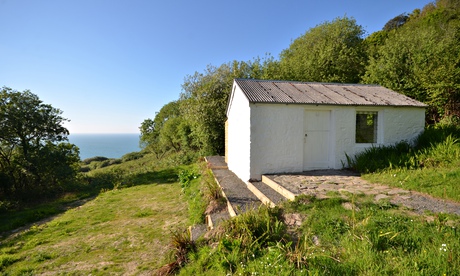
It’s not often you get invited to stay in a pigsty. It’s even less often that you accept. But when the invitation comes from the National Trust and promises sea views away from any neighbours in north Devon, there is only one sensible response.
That’s how I came to be making my way on foot along the South West Coast Path from Westward Ho! to Peppercombe in mizzly rain, bound for a pigsty. At 630 miles long – running between Minehead, in Somerset, and Poole Harbour, in Dorset – stretches of this National Trail are walked every year by millions of people (6.2 million in 2011). Until now, the accommodation options for multi-day trips were B&Bs – comfy but not for the budget-conscious – or campsites, a good money saver, but involving a much heavier backpack and not so good in rain and wind.
Thank goodness, then, that the National Trust, which owns many sections of this coastal walk, has just opened its first bothy – a good alternative, at least for one night only.
Essentially a stone tent, a bothy is defined as a building created for another purpose (this was a piggery built between 1900 and 1920) and now used by outdoors lovers as a basic shelter. Looked after by the volunteer-run Mountain Bothies Association, most are found in Scotland (where they were once shepherds’ or gamekeepers’ huts) with a handful in mountainous areas of Wales and northern England. Visitors need to bring the basics: cooking stove, sleeping bag and mat – but crucially bothies offer four solid walls and a roof.
This bothy is part of a new National Trust scheme to get people into the great outdoors. “We’re looking at more ways for visitors to use the special places we care for,” says National Trust head of holidays James Ingham. “Bothies offer the chance to pare things down to bare essentials.”
The National Trust started offering cottage stays in the 1950s – these now include water towers, lighthouses and a roundhouse – and has three other bothies, all in the Lake District (but these aren’t camping bothies as they have hot showers, cookers and rangers on hand to help you out).
Damp and bedraggled from my half-day walk, I arrive up a newly laid stone track through trees a little way from the shingle beach at Peppercombe. I peer between the leaves and spot a whitewashed stone hut with a tin roof. At the stable-style door, I punch in the padlock code given to me when I booked (once you book, it’s yours exclusively for the night), then enter the gleaming white space.
The fireplace is sadly defunct (no fires are allowed inside). But there’s a shelf with National Trust leaflets and a visitors’ book, and two large, raised sleeping platforms, each a little higher than a standard bed and wide enough for two, with windows letting light in (there is no electricity). It’s basic, but embroidered curtains add a country-cottage feel. There’s a small worktop and a sink with cold running water. The “kitchen” window looks out on to wildflowers and bracken, then across to the Isle of Lundy.
As the rain eases, I hang my jacket over a beam and spread my kit around to dry. I head back outside to watch the sky glow orange in the dusk. At the back of the building I find the toilet, a small wooden lean-to hut. This is quite a luxury in bothying terms, where usually a shovel is the only bathroom apparatus provided.
I had brought a dehydrated pasta meal for my dinner but, happily, the Coach and Horses pub is just 10 minutes’ walk up the private road to Horns Cross, so I have a Sunday roast then return to my hut to read about the area by candlelight and snuggle into my sleeping bag, listening to the rain tap on the windows. I sleep easily, free from the worries of loose guylines or billowing fabric that I usually suffer when spending the night in a tent, and wake with the dawn chorus. A deer grazes on the path outside.
With some walking planned for the day to the cobbled village of Clovelly to the west, I take advantage of the space a bothy offers, poring over my fully opened map, luxuriating in getting ready in a space where I can stand up straight, and making breakfast with no damp canvas walls slapping against my arms.
Before leaving, I pick up the visitors’ book and smile as I leaf through all the blank pages waiting for people to write in them. If this bothy proves a success, the National Trust will restore and open five more similar old buildings on the coast between north Cornwall and west Somerset, from former shepherd’s huts to fishermen’s shelters and, of course, pigsties. And the best thing is – we’re all invited.
• Accommodation was provided by Peppercombe Bothy, which sleeps four, with exclusive use £20 a night. Book in advance at nationaltrust.org.uk/holidays/camping/bothies-bunkhouses/
Phoebe Smith’s latest book is Wild Nights: Camping Britain’s Extremes (Summersdale, £9.99). To buy a copy for £7.99 including UK p&p, call 0330 333 6846 or visit bookshop.theguardian.com

